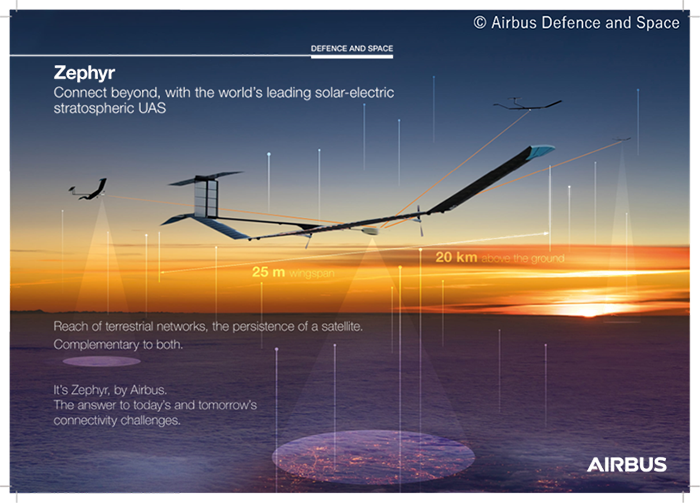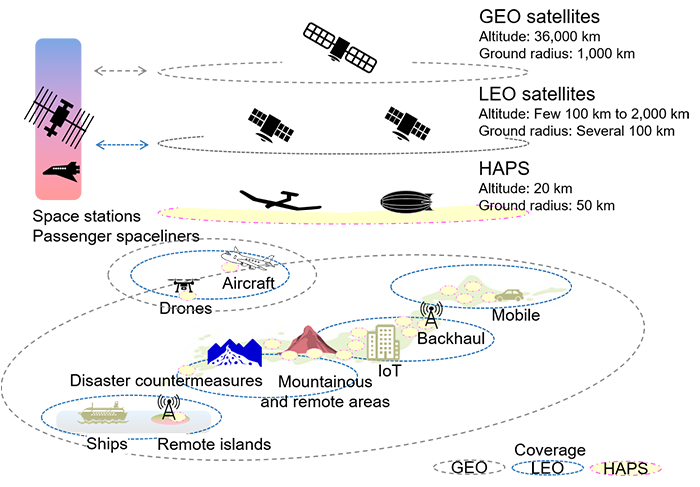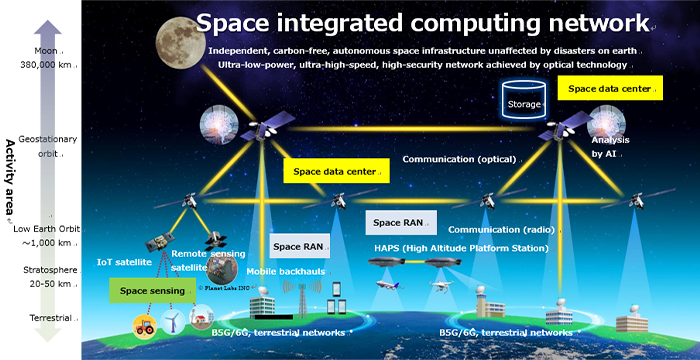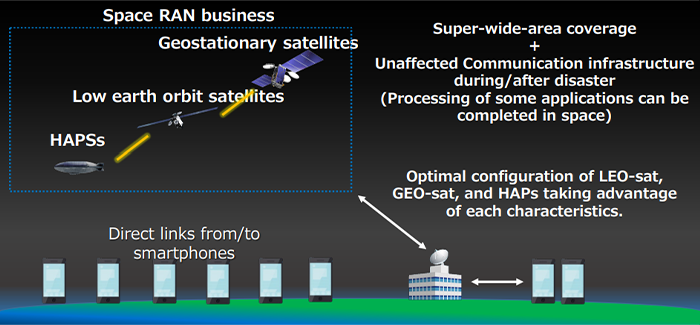New partnership targets future global wireless-connectivity services combining satellites and HAPS
NTT, its mobile subsidiary DoCoMo, aircraft maker Airbus, and Japanese satcoms Sky Perfect JSAT Corporation are partnering to conduct a feasibility study on high altitude platform stations (HAPS). Deployed at altitudes of around 20 kilometers, they are essentially flying base stations that can provide coverage to a radius of around 50 kilometers.
Launched with a memorandum of understanding (MOU), the study will attempt to identify the early deployment requirements of a HAPS-based network. The collaboration will investigate the use of the Airbus Zephyr, the leading solar-powered, stratospheric unmanned aerial system (UAS), and the wireless communication networks of NTT, DOCOMO and SKY Perfect JSAT in order to test HAPS connectivity, identify practical applications, develop required technologies and ultimately launch space-based wireless broadband services.
Illustration of Airbus “Zephyr” HAPS aircraft:

In the global push to further advance 5G and eventually introduce 6G, initiatives are under way to expand coverage worldwide, including in the oceans and in the air. Such initiatives will include HAPS, which fly in the stratosphere about 20 km above the earth, and non-terrestrial network (NTN) technologies using geostationary-orbit (GEO) satellites and low Earth-orbit (LEO) satellites.
HAPS networks are deemed to be a relatively easy solution for air and sea connectivity and an effective platform for deploying disaster countermeasures and many industrial applications. The provision of space-based radio access network services using NTN technologies, collectively called Space RAN (radio access network), is expected to support worldwide mobile communications with ultra-wide coverage and improved disaster resistance as well enhanced 5G and 6G. In addition,
HAPS platforms can also interconnect to the nearest terrestrial network gateway and extend the reach of existing mobile services directly to end-user devices, providing service options including as rural, emergency and maritime connectivity.

With the signing of the MOU, the four companies will discuss and identify possible future developments necessary to unlock future HAPS-based connectivity services, lobby for standardization and institutionalization of HAPS operations, and explore business models for commercializing HAPS services.
Specific themes will include the applicability of HAPS for mobile connectivity on the ground and base station backhaul,1 the performance of various frequency bands in HAPS systems, the technological considerations for linking HAPS with satellites and ground base stations, and the establishment of a cooperative system to test a network combining NTN technology, satellites and HAPS.
As separately announced on November 15, 2021, DOCOMO and Airbus have successfully conducted a propagation test between the ground and a “Zephyr S” HAPS aircraft in the stratosphere, demonstrating the possibility of providing stable communication with such a configuration.


…………………………………………………………………………………………………………….
Nick Wood of Telecoms.com wrote:
If the group achieves its stated objectives, it will have succeeded where a few other big names have failed.
Google, which has a long and rich history of dabbling, had a go at HAPS in 2011. Project Loon as it was called, consisted of a fleet of stratospheric balloons with base stations dangling beneath them. It was spun out of Google’s ‘X’ lab into a standalone company in 2018 and launched its first commercial service in partnership with Telkom Kenya in 2020. However, Project Loon couldn’t drive the costs down low enough to turn it into a viable long-term business, and the whole enterprise ceased operations around this time last year. Alongside Project Loon, Google also flirted with drone-based connectivity. This one was called Project Titan, and it fared even worse than Loon. Test flights began in 2015, but amid rumours of funding issues and technical difficulties, the whole thing was canned in early 2016.
Meta (previously known as Facebook) also had a crack at HAPS. As part of its effort to connect the unconnected and sell their data to advertisers, in 2016 it showed off Aquila: a portable fleet of unmanned, solar-powered drones that would deliver service to rural areas. It gave up on the idea two years later after reaching the not-so-startling conclusion that it wasn’t particularly good at building aircraft.
Despite these high-profile failures, the aviation and telecoms industries are clearly not ready to give up on HAPS just yet. They even launched their own lobby group in February 2020, the HAPS Alliance. Last month it announced the successful test flight of Sunglider, an unmanned, solar-powered aircraft equipped with an LTE base station. Funnily enough, Airbus, DoCoMo and Sky Perfect JSAT are all members of the HAPS Alliance, which aims to create an ecosystem around the technology that will turn it into a sustainable business.
DoCoMo et al are undoubtedly aware of the unproven business case for this technology, and so spreading the risk across several experts – rather than going it alone like Google and Facebook – is probably better than the HAPS-hazard approach taken by those giants of Silicon Valley.
References:
https://www.nttdocomo.co.jp/english/info/media_center/pr/2022/0117_00.html
https://www.nttdocomo.co.jp/english/info/media_center/pr/2021/1115_00.html
NTT hopes to succeed where Google Loon and Facebook Aquila failed
One thought on “New partnership targets future global wireless-connectivity services combining satellites and HAPS”
Comments are closed.



“HAPS-hazard” – good one. With a consortium approach, maybe this will succeed where Alphabet and Meta failed.
If electric aviation takes off (pun intended) and greatly expands regional travel, the demand for aircraft-based Internet for passengers is going to also increase accordingly.
https://viodi.com/2021/06/15/distributed-electric-aviation-a-new-model-of-intercommunity-connection/
Further, the U.S. Army has been looking at a flying cell tower approach with satellite backhaul for a while and, with SpaceX/Starlink as a partner, created a proof-of-concept to bring ad-hoc Internet where needed.
https://www.c4isrnet.com/air/2020/01/06/what-if-air-force-tankers-became-a-communications-node/